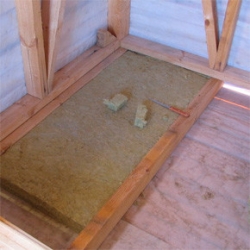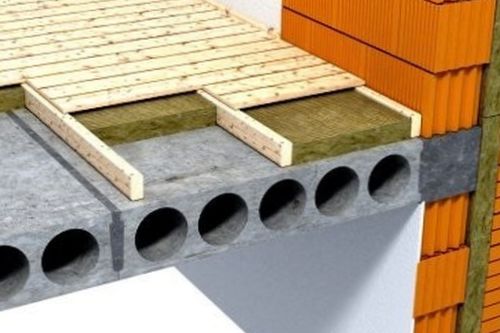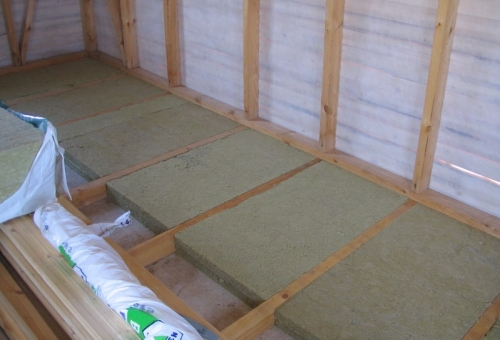Ceramic tiles for wood are one of the most convenient materials for ...
|
|
Each time before planning the future repair, a number of questions arise before us ... |
The modern building materials market offers a wide selection of finishing funds ... |
Floor insulation of the first floor

To insulate in the house the floors on the ground floor is a mandatory task. It cannot be the only solution to achieve complete comfort in the dwelling and often is only a stage from a whole complex of measures to provide heat. We are talking about insulation of walls, ceiling, entrance groups and window openings. But it is most logical to start taking care of thermal insulation still from the floor. The article will talk about warming the floor of the first floor.
Content:
- The floor of the first floor
- Floor insulation for the first floor
- Tips for choosing insulation for the floor of the first floor
- Thermal insulation of the floor of the first floor using expanded clay
- Floor insulation of the first floor using mineral or glass wool
- DIY floor insulation of the house with foam
- The correct use of extrusion polystyrene in creating thermal insulation of the floor
The floor of the first floor
To begin with, it is worth deciding what type of widest assortment of materials will be insulated. The most in demand at the moment are:
- styrofoam;
- polystyrene foam;
- dry clay screed;
- glass wool;
- mineral (stone) cotton wool.
They differ not only in cost, but also in a number of characteristics that should be considered in more detail. Since some of the proposed materials are similar or mistaken for analogues, a comparative characteristic will help to decide on the choice.
Floor insulation for the first floor
Foam or foamed polystyrene
- If we talk about kinship, then these two heater, undoubtedly, have. Foam is somewhat older, polystyrene foam is rather its improved version.
- Differences begin at the production stage. Polystyrol granules are used as raw materials. To obtain foam, they are treated with a stream of hot air, and they, expanding, are connected. A product with a porous structure is formed. The extrusion method is more progressive, and as a result of its use, granules of the source material are melted. The output is material with a single structure, more dense than the above copy. In this case, the cellular structure, which helps to keep heat, is preserved in it.
- The foamed polystyrene is stronger than his brother for bending 5-6 times, and he will not crumble if the conditions of the external environment change. In addition, polystyrene foam absorbs moisture worse, and thanks to the improved density indicator, it absorbs noise more effectively.
- Both materials are small and non -toxic (subject to the use of high -quality construction products from trusted brands). They are also not subject to decay and mold does not form on them. Fires are good for both products. It is more advisable to use foam to warm floors in those rooms where small cross -country ability is expected, and the surface will not experience additional loads from, for example, massive furniture. It is also suitable for those who want to save. However, as follows from the above technical characteristics, such a desire is not always appropriate.
Glass wool or mineral wool
Another difficult task is to choose between glass wool and mineral wool.
- The latter has very impressive indicators for refractory, so it is most often used when warming the wooden floor. The natural inorganic origin of stone cotton wool gives the right to talk about its environmental friendliness, resistance to the propagation of pathogenic microorganisms.
- The thermal insulation properties of the mineral wool are not questioned. It is safe to say that its use will reduce the cost of heating the premises. It will also provide a high level of sound insulation. All these wonderful properties will not work if the installation technology is broken during the insulation of the floor. Therefore, when giving preference to Rockwell, you should clearly follow the recommendations for installation.
- The glass wool differs in that it is based on a broken glass, that is, in fact, there is no related attitude to mineral cotton wool. At the same time, she loses to her (slightly) in the indicator for thermal insulation and even in the ability to shrink over time. In addition, working with her is not as comfortable as with Rockwall due to the formation of fine glass dust, annoying the respiratory tract and hands, if they are not protected. But it will cost much cheaper than a stone analogue. So those who agree to experience some discomfort when laying the material and want to save, you can opt for the glass wool.
The advantages of expanded clay
- This porous material is, in fact, clay. It is formed by granules and processed at high temperatures. As a result, an excellent insulation is obtained, its make -ups allows you to easily fill all the voids.
It is good in several indicators:
- durability;
- environmental friendliness;
- non -combustibility;
- complete resistance to the development of microorganisms, does not cause interest in rodents and other pests;
- cheapness.
- Due to the porous structure, it is a fairly light material, but inferior in this indicator to other heaters, including those described earlier. And expanded clay creates a beautiful layer that contributes to natural ventilation. Sound insulation achieved after its application is considered one of the best.
- The thickness of the floor of the first floor can also play against expanded clay, since the organization of a high -quality layer of thermal insulation will require a significant supply in height. The minimum recommended bedding layer is 20 cm, and 40 cm is considered optimal. And again, one should not forget to add the height of the screed.
Tips for choosing insulation for the floor of the first floor
- To finally decide on the material for insulation, you will need to take into account many factors. At the cost of glass wool, foam or expanded clay, the most preferred options.
- If the time is a decisive indicator, then the foam is easily and easier to lay.
- When you need to complete the procedure according to all the rules and requirements of fire safety, mineral wool will be the best choice.
- And also an important criterion were and remain the needs and capabilities of the owners of the structure. But in any case, on your own, to do all the work for any home master.
Thermal insulation of the floor of the first floor using expanded clay
Ceramzit is very well gaining moisture. This is the main disadvantage of this material. Therefore, the construction of a high -quality waterproofing layer becomes the first and very priority step. Next, a detailed floor of the first floor floor will be painted when using expanded clay.
- Moisture protection. The most commonly used for these purposes the material is a polyethylene film. You need to take as strong as possible. Naturally, one canvas cannot be dispensed with, so the junction of the joint is carefully glued with construction tape. The calculation when creating a waterproofing panel should be with an emphasis that its edges should be exceeding the entire alleged add -on along with the screed. Extra centimeters after you can cut.
- Cooking the insulation. The preparation of a mixture from the material of various fractions is contributed to the maximum effect. The use of expanded clay dimensions from 5 to 20 mm will serve as the best distribution of granules and will create a more acceptable base for adhesion to concrete.
- Lighthouses. Their exhibition is necessary to create a perfectly flat surface without drops and slopes. The first is located at a distance from the walls of a few centimeters. Fixation is carried out on small heaps of a fairly thick cement mortar. Further, the beacons are placed in parallel to the first. The installation distance corresponds to the length of the rule. It will be used for subsequent alignment of the screed. Usually, a metal profile is used for guides. If the floor insulation followed by filling is carried out independently for the first time, then it is better not to save on the number of lighthouses.
- The prepared expanded clay can be filled up. It is evenly distributed and slightly compacted. The level of backfill needs constant control to avoid slopes. Then you need to impregnate the pouring with a solution of liquid cement. Such cement milk will give the strength of the insulation layer and allow it to remain in the original position with further pouring. A reinforcing layer of a metal mesh will become a final step at this stage.
- Pouring. The prepared solution is evenly distributed from the wall by the level of beacons. Smooth the rule. So gradually move to the entrance to the room.
- You can walk on the screed not earlier than after 7 days, but completely the coating will harden and will be ready for the finish in a month. While the drying process is underway, in order to avoid cracking, we should moisten the future floor with water. Verification for readiness can be carried out in this way: put a glass down a glass jar. If condensate is formed on its walls, it means that there is a lot of moisture in the floor and proceed to laying the finish coating so far.
- The result is a durable and warm flat surface, on which tiles, laminate or any other type of flooring will look perfect.
As an option, you can consider a dry screed using expanded clay and GVL (gypsum fiber sheets).
- Creating a waterproofing layer. It is mounted, as in the first case, the joints are overlapped by about 20 cm, and a stock of 6-7 cm is made on the walls.
- Along the entire perimeter of the room, the places of contact with the wall are closed with a damping ribbon.
- Lighthouses are exhibited.
- Ceramzit is falling asleep in portions. It is leveled and slightly compacted. After that, be sure to check the correspondence of the height by level. This operation is performed gradually in separate areas. As soon as one piece of floor is prepared, it is immediately covered with a slap of GVL. It is laid in two layers, gluing with each other and additionally fastened with self -tapping screws.
- The seams at the joints of the GVL are spit, you can walk along them with a layer of bitumen waterproofing.
- The remains of the film and the damping tape are cut off, the base is ready for the finish.
Floor insulation of the first floor using mineral or glass wool
If the desire to insulate the floor arose already during the operation of the structure, then first it will be necessary to get rid of the old floor material. When the boards are dismantled, which in the future is planned to be returned to the place, for the convenience of assembly they can be numbered.
- The state of the lag and the rough flooring is evaluated. If there are rotten elements, then at first work is carried out to replace them.
- Waterproofing. It is better to choose polyethylene with a density of 100 microns and above. It is laid over 10 cm. Near the walls, it is necessary to leave its supply by height by about 10 15 cm. If groundwater lies too close to the surface, then it is preferable to choose a roofing or peramin as vapor barrier.
- Between the lags of the final sex the selected insulation is laid. It is covered with another layer of insulating material on top.

- With a thickness of 2 cm, the counter is built. Its function to provide ventilation gap.
- A new flooring is built or previous boards are mounted back.
If you need to insulate the concrete floor of the first floor with mineral wool, then the lags are first mounted. Steamed films will not be required.

DIY floor insulation of the house with foam
- Waterproofing layer It is created according to the technologies described earlier. It is assumed that it is laid on the aligned surface.
- Lights are exhibited on top.
- A cement screed is performed. Its thickness is 4 cm.
- On her in a checkerboard pattern foam plates are mountedwho, when laying, are tightly driven to each other. After that, the screed is left alone for a couple of days.
- After the first layer dries, a final screed is performed. The beacons for her are attached to the heater slabs. The thickness of the cement layer is 70 mm. Its pouring is performed using a reinforcing grid. After leveling and drying the solution, the floor is ready for decoration with any coating.
The correct use of extrusion polystyrene in creating thermal insulation of the floor
- If the polystyrene foam is laid inside the lag, then they should be located from each other at a distance of 60 cm.
- The waterproofing layer is originally laid, and then the insulation is tightly laid between the lags.
- With the help of a construction stapler, another layer of vapor barrier is fixed on top. From above, this puff structure is closed with plywood sheets or boards.
- A prerequisite is a ventilation gap that is left around the perimeter of the entire room (approximately 0.5 cm). It will not be noticeable after the installation of skirting boards.
- At a relatively high cost, foamed polystyrene creates a high -quality and warm layer that will last a long time. However, experts recommend taking into account the following moment when using it: if the polystyrene foam was used to warm the floors, then with a similar procedure with the ceiling and walls it is better to give preference to more breathing materials so as not to create a greenhouse effect in the home.








